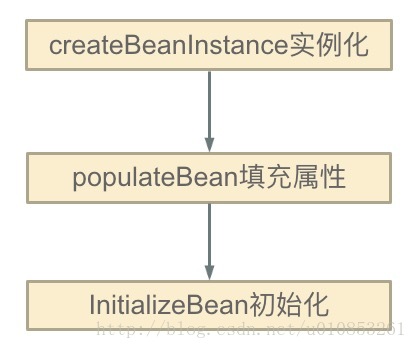标签:obj toolbar nta 依赖注入 context 标识符 注入 size tst
是循环依赖,对象A中要实例化B,对象B中要实例化C,对象C中药实例化A,最后相互等待而导致异常的发生。
检测循环依赖相对比较容易,Bean在创建的时候可以给该Bean打标记,如果递归调用回来发现正在创建中的话,即说明了循环依赖了。
public class StudentA {
private StudentB studentB ;
public void setStudentB(StudentB studentB) {
this.studentB = studentB;
}
public StudentA() {
}
public StudentA(StudentB studentB) {
this.studentB = studentB;
}
}
public class StudentB {
private StudentC studentC ;
public void setStudentC(StudentC studentC) {
this.studentC = studentC;
}
public StudentB() {
}
public StudentB(StudentC studentC) {
this.studentC = studentC;
}
}
public class StudentC {
private StudentA studentA ;
public void setStudentA(StudentA studentA) {
this.studentA = studentA;
}
public StudentC() {
}
public StudentC(StudentA studentA) {
this.studentA = studentA;
}
}
上面是很基本的3个类,,StudentA有参构造是StudentB。StudentB的有参构造是StudentC,StudentC的有参构造是StudentA ,这样就产生了一个循环依赖的情况,
我们都把这三个Bean交给Spring管理,并用有参构造实例化
<bean id="a" class="com.liuqing.student.StudentA"> <constructor-arg index="0" ref="b"></constructor-arg> </bean> <bean id="b" class="com.liuqing.student.StudentB"> <constructor-arg index="0" ref="c"></constructor-arg> </bean> <bean id="c" class="com.liuqing.student.StudentC"> <constructor-arg index="0" ref="a"></constructor-arg> </bean>
下面是测试类
public class Test {
public static void main(String[] args) {
ApplicationContext context = new ClassPathXmlApplicationContext("com/liuqing/student/applicationContext.xml");
//System.out.println(context.getBean("a", StudentA.class));
}
}
执行结果报错信息为:
Caused by: org.springframework.beans.factory.BeanCurrentlyInCreationException: Error creating bean with name ‘a‘: Requested bean is currently in creation: Is there an unresolvable circular reference?
2、setter方式单例,默认方式
Spring中Bean实例化的图
如图中前两步骤得知:Spring是先将Bean对象实例化【依赖无参构造函数】--->再设置对象属性的
<!--scope="singleton"(默认就是单例方式) -->
<bean id="a" class="com.liuqing.student.StudentA" scope="singleton">
<property name="studentB" ref="b"></property>
</bean>
<bean id="b" class="com.liuqing.student.StudentB" scope="singleton">
<property name="studentC" ref="c"></property>
</bean>
<bean id="c" class="com.liuqing.student.StudentC" scope="singleton">
<property name="studentA" ref="a"></property>
</bean>
下面是测试类:
public class Test {
public static void main(String[] args) {
ApplicationContext context = new ClassPathXmlApplicationContext("com/liuqing/student/applicationContext.xml");
System.out.println(context.getBean("a", StudentA.class));
}
}
打印结果为:
com.liuqing.student.StudentA@1fbfd6
我们结合上面那张图看,Spring先是用构造实例化Bean对象 ,此时Spring会将这个实例化结束的对象放到一个Map中,并且Spring提供了获取这个未设置属性的实例化对象引用的方法。 结合我们的实例来看,,当Spring实例化了StudentA、StudentB、StudentC后,紧接着会去设置对象的属性,此时StudentA依赖StudentB,就会去Map中取出存在里面的单例StudentB对象,以此类推,不会出来循环的问题
3、setter方式原型,prototype
修改配置文件为:
<bean id="a" class="com.liuqing.student.StudentA" scope="prototype">
<property name="studentB" ref="b"></property>
</bean>
<bean id="b" class="com.liuqing.student.StudentB" scope="prototype">
<property name="studentC" ref="c"></property>
</bean>
<bean id="c" class="com.liuqing.student.StudentC" scope="prototype">
<property name="studentA" ref="a"></property>
</bean>
scope="prototype" 意思是 每次请求都会创建一个实例对象。两者的区别是:有状态的bean都使用Prototype作用域,无状态的一般都使用singleton单例作用域。
测试用例:
public class Test {
public static void main(String[] args) {
ApplicationContext context = new ClassPathXmlApplicationContext("com/liuqing/student/applicationContext.xml");
//此时必须要获取Spring管理的实例,因为现在scope="prototype" 只有请求获取的时候才会实例化对象
System.out.println(context.getBean("a", StudentA.class));
}
}
打印结果:
Caused by: org.springframework.beans.factory.BeanCurrentlyInCreationException:
Error creating bean with name ‘a‘: Requested bean is currently in creation: Is there an unresolvable circular reference?
对于“prototype”作用域Bean,Spring容器无法完成依赖注入,因为“prototype”作用域的Bean,Spring容器不进行缓存,因此无法提前暴露一个创建中的Bean。
四、Spring怎么解决循环依赖

三级singletonFactories : 单例对象工厂的cache
标签:obj toolbar nta 依赖注入 context 标识符 注入 size tst
原文地址:https://www.cnblogs.com/yebingluo/p/13303138.html